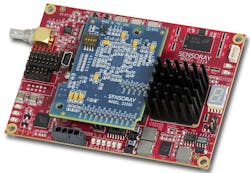Audio/video encoder embedded computing board for video processing introduced by Sensoray
TIGARD, Ore., 9 July 2015. Sensoray Co. Inc. in Tigard, Ore., is introducing the model 2224 HD/SD audio/video H.264 encoder embedded computing board for video processing applications such as high-profile DVRs, NVRs, and stream servers.
The encoder's single SDI input supports 1080p, 1080i, 720p and NTSC/PAL video resolutions, and features a USB 2.0 connection to its host CPU.
The 2224 encoder outputs H.264 High Profile Level 4 for HD and main profile level 3 for SD, multiplexed in MPEG-TS (transport stream) format. The board has overlay generators, integral HD/SD raw frame grabber, and live preview stream.
This encoder is Blu-Ray compatible and allows for full screen 16-bit color text/graphics overlay with transparency. Any true-type font can be displayed; graphics can be displayed from standard BMP files or generated by Sensoray's 2224 API, which allows graphics to be placed and moved anywhere on the screen.
Additionally, the board can send an uncompressed, down-scaled video stream over USB, offering users low-latency live video previewing on the host computer with minimal CPU usage.
Related: Encoder board for video-processing in DVR, NVR, and streaming servers offered by Sensoray
The 2224 can source audio from embedded SDI audio, external line input, or optional on-board microphone preamplifier, and output audio in either stereo or mono to the encoded stream.
The board employs special hardware and advanced techniques to keep audio synchronized to video and eliminate the lip sync errors that plague many software-based solutions.
For more information contact Sensoray online at www.sensoray.com.

